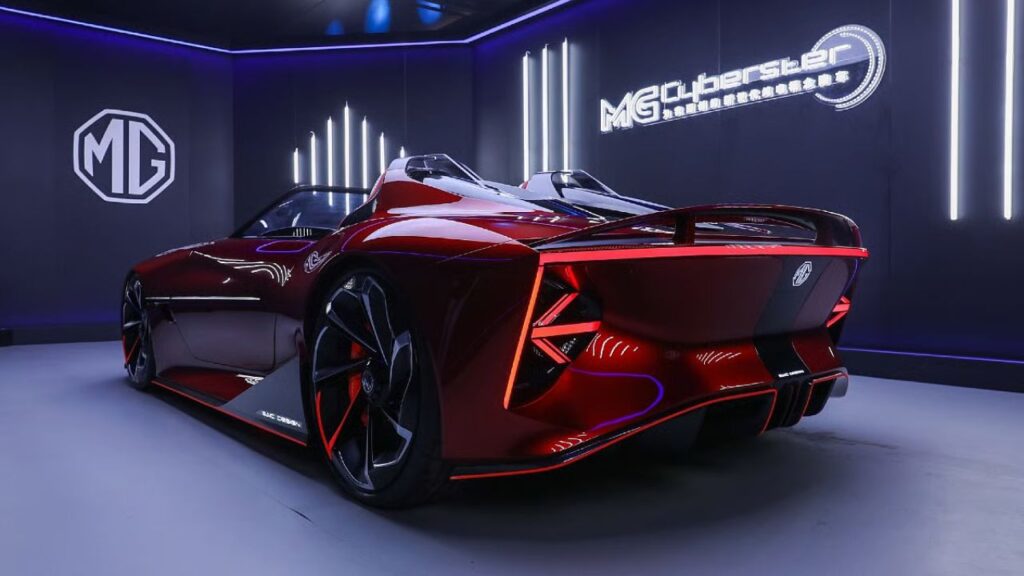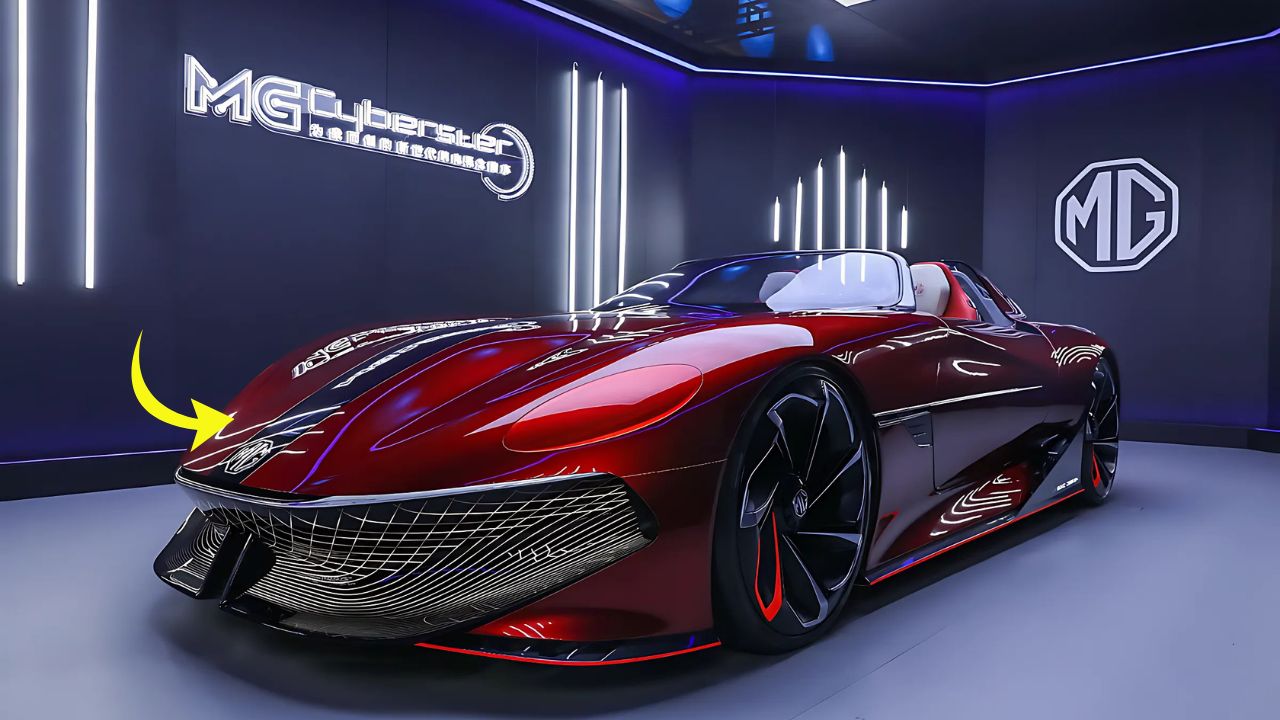The automotive world rarely witnesses the resurrection of iconic nameplates, but MG has achieved exactly that with the Cyberster. This electric roadster brings the legendary MG badge into the modern era with spectacular style and performance.
At $115,000, the Cyberster positions itself firmly in premium territory. This pricing strategy signals MG’s intention to compete with established luxury sports car manufacturers rather than budget-focused competitors.

Revival of a Legendary Nameplate
MG’s history stretches back nearly a century, with sports cars forming the brand’s foundation. The Cyberster represents a return to these roots while embracing contemporary electric vehicle technology.
Modern interpretation respects heritage while pushing boundaries. Design elements reference classic MG roadsters without becoming pastiche, creating something genuinely fresh and contemporary.
Design Philosophy and Aesthetic Excellence
Contemporary automotive design often prioritizes efficiency over emotion. The Cyberster deliberately chooses emotional impact, creating a vehicle that stops traffic and starts conversations.
Proportions follow classic sports car principles. Long hood, short deck, and low-slung stance create visual drama that photographs beautifully and looks even better in person.
Scissor doors provide theatrical entry. While some may consider this feature excessive, it reinforces the Cyberster’s positioning as something special rather than merely practical transportation.
LED lighting systems create distinctive signatures. Both front and rear lighting incorporate animated sequences that enhance the vehicle’s futuristic character.
Interior Design and Luxury Features
Cabin design balances sport and luxury. Premium materials throughout justify the asking price while maintaining the focused atmosphere appropriate for a performance vehicle.
Digital displays dominate the dashboard. Multiple screens provide comprehensive information while maintaining clean, uncluttered aesthetics that complement the exterior design.
Seating accommodates two occupants in genuine sports car fashion. The seats provide excellent support during spirited driving while remaining comfortable for extended journeys.
Convertible top operation happens quickly and quietly. The soft-top mechanism stores compactly, maintaining trunk space when open-air driving is desired.
Electric Performance Engineering
Electric powertrains offer unique advantages for sports car applications. Instant torque delivery and low center of gravity create ideal conditions for exceptional performance.
Battery placement optimizes weight distribution. Low-mounted battery packs contribute to the Cyberster’s excellent handling characteristics while providing structural rigidity.
Powertrain Specifications and Capabilities
Multiple motor configurations provide different performance levels. Base models offer substantial performance, while flagship variants deliver supercar-level acceleration.
All-wheel drive systems distribute power intelligently. Electronic torque vectoring enhances cornering performance while maintaining stability during aggressive driving.
Range optimization balances performance with practicality. Real-world testing suggests official range figures remain achievable despite the vehicle’s performance focus.
Charging technology supports rapid replenishment. DC fast charging capabilities ensure the Cyberster can complete longer journeys without excessive delays.
Handling and Dynamics
Suspension systems combine comfort with performance. Adaptive dampers adjust to driving conditions and driver preferences, providing versatility for different usage scenarios.
Steering calibration emphasizes feedback and precision. Electric power assistance maintains the natural feel that sports car enthusiasts demand.
Braking systems provide exceptional stopping power. Large disc brakes with advanced calipers ensure consistent performance during extended track sessions.
Electronic stability systems enhance rather than limit performance. Multiple driving modes allow experienced drivers to explore the vehicle’s capabilities safely.
Market Positioning and Competition Analysis
The $115,000 price point places the Cyberster among established luxury sports cars. This positioning requires exceptional execution to justify the premium over more affordable alternatives.
Target buyers likely prioritize uniqueness over pure value. The Cyberster appeals to customers seeking something distinctive rather than the most rational choice.
Direct Competitors and Market Comparison
Traditional sports car manufacturers offer established alternatives. Porsche Boxster, BMW Z4, and Mercedes SL-Class all compete for similar buyers with proven track records.
Electric vehicle competitors remain limited. Tesla Roadster development continues slowly, while other manufacturers focus on SUVs and sedans over sports cars.
Value proposition depends on individual priorities. Buyers seeking maximum performance per dollar have better options, while those prioritizing uniqueness may find the Cyberster compelling.
Brand perception challenges MG initially. The brand’s budget-focused recent history contrasts sharply with the Cyberster’s premium positioning.
Luxury Features and Equipment Levels
Standard equipment justifies the premium pricing. Comprehensive feature lists ensure buyers receive appropriate value for their investment.
Technology integration matches contemporary expectations. Advanced infotainment and driver assistance systems compete with established luxury brands.
Build quality appears substantially improved. MG has invested heavily in manufacturing processes to ensure the Cyberster meets premium standards.
Materials selection emphasizes luxury credentials. Premium leather, metal trim, and high-quality plastics create appropriate ambiance for the price point.
Australian Market Introduction
Bringing the Cyberster to Australia required extensive planning and preparation. MG has invested significantly in ensuring successful market introduction.
Local adaptation addressed Australian-specific requirements. Climate testing, regulatory compliance, and service infrastructure preparation preceded the launch.
Dealer Network and Service Infrastructure
MG’s Australian dealer network has evolved considerably. Facilities now include showrooms capable of displaying premium vehicles appropriately.
Service technician training ensures proper maintenance support. Complex electric vehicle systems require specialized knowledge and equipment.
Parts availability could challenge early adopters. Premium vehicle owners expect minimal service delays, requiring comprehensive parts inventory.
Warranty coverage provides necessary confidence. Extended warranty options suit buyers investing in relatively unproven technology.
Regulatory Compliance and Certification
Australian Design Rules required specific modifications. The Cyberster achieved compliance while maintaining its essential character and performance.
Safety certifications remain pending in some areas. ANCAP testing will be crucial for market acceptance and insurance considerations.
Import regulations favored electric vehicles. Government policies supporting electric vehicle adoption helped facilitate the Cyberster’s introduction.
Technology Integration and Innovation
Modern luxury vehicles require sophisticated technology systems. The Cyberster incorporates contemporary features while maintaining focus on driving experience.
Infotainment systems provide comprehensive connectivity. Multiple screen configurations support various information types and user preferences.
Advanced Driver Assistance Systems
Electronic safety systems enhance confidence without compromising engagement. Carefully calibrated systems provide assistance while maintaining the pure driving experience sports car buyers expect.
Adaptive cruise control suits highway touring. Long-distance comfort improves significantly with intelligent speed and distance management.
Lane keeping assistance provides gentle guidance. The system helps maintain position without feeling intrusive or overwhelming.
Emergency braking systems provide ultimate safety backup. Comprehensive sensor arrays can detect potential collisions and intervene when necessary.
Connectivity and Digital Integration
Smartphone integration supports contemporary usage patterns. Both Android Auto and Apple CarPlay ensure seamless connectivity with user devices.
Over-the-air updates maintain currency. Software improvements can add features and enhance performance throughout ownership.
Navigation systems include charging station information. Route planning considers charging requirements for longer journeys.
Remote monitoring allows owners to check vehicle status. Smartphone apps provide battery levels, charging progress, and security monitoring.
Ownership Experience and Practical Considerations
Daily usability matters even for weekend sports cars. The Cyberster balances performance focus with practical requirements for regular use.
Storage space limitations are inevitable in sports car design. Owners must accept compromises in luggage capacity and passenger accommodation.
Running Costs and Maintenance
Electric powertrains typically require less maintenance. Fewer moving parts mean reduced service requirements compared to combustion engine alternatives.
Electricity costs vary significantly with usage patterns. Home charging provides economical operation, while public fast charging increases costs substantially.
Insurance costs may reflect the vehicle’s value and performance. Comprehensive coverage for a $115,000 sports car requires significant annual premiums.
Depreciation rates remain uncertain for new electric vehicles. Early adopters may face higher than expected value losses as technology advances rapidly.
Real-World Performance and Efficiency
Track performance capabilities exceed most owners’ requirements. The Cyberster provides genuine sports car performance for those occasions when it’s needed.
Highway efficiency impresses despite performance focus. Aerodynamic optimization helps maintain reasonable range during highway cruising.
City driving showcases electric advantages. Silent operation and instant response enhance the urban driving experience significantly.
Climate control affects range substantially. Air conditioning use in Australian conditions can reduce available range considerably.
Environmental Impact and Sustainability
Electric vehicles offer environmental advantages over combustion alternatives. The Cyberster contributes to emission reductions while providing exceptional performance.
Manufacturing processes continue improving sustainability. MG has implemented environmental management systems throughout production.
Carbon Footprint and Lifecycle Assessment
Local electricity generation affects overall environmental impact. Australia’s increasing renewable energy adoption improves electric vehicles’ environmental credentials over time.
Battery production represents significant environmental impact. However, operational emissions remain zero, providing long-term environmental benefits.
End-of-life considerations include battery recycling. Comprehensive recycling programs ensure responsible disposal of electric vehicle components.
Future Environmental Developments
Renewable energy integration continues expanding. Home solar systems can provide truly zero-emission vehicle operation.
Battery technology improvements reduce environmental impact. Next-generation batteries require fewer rare materials while providing better performance.
Recycling technology advances enable better resource recovery. Improved processes can reclaim valuable materials from used batteries.
Market Response and Industry Impact
Early market response suggests strong interest in the Cyberster concept. However, translating interest into sales requires successful execution across all aspects.
Industry observers note the significance of MG’s premium positioning. Success could encourage other manufacturers to develop electric sports cars.
Consumer Reception and Feedback
Initial reviews emphasize the Cyberster’s visual impact. Automotive journalists praise the design while noting areas for improvement in execution.
Test drive feedback focuses on performance capabilities. The electric powertrain provides exceptional acceleration that impresses even experienced sports car drivers.
Build quality assessments vary among reviewers. Some note improvements over previous MG products, while others suggest premium competitors still lead.
Value perception depends heavily on individual priorities. Buyers seeking uniqueness may find good value, while those prioritizing pure performance have alternatives.
Long-Term Market Prospects
Success depends on maintaining product development momentum. Continuous improvement will be necessary to compete with established luxury manufacturers.
Brand building requires consistent execution. MG must deliver excellent customer experiences to establish credibility in the premium segment.
Electric vehicle market evolution affects all players. Rapid technology advancement means today’s specifications may seem outdated quickly.
Future Development and Evolution
The Cyberster represents MG’s current capabilities but will likely evolve significantly. Future updates may address initial shortcomings while adding new features.
Electric vehicle technology advances rapidly. Next-generation batteries and motors could substantially improve performance and efficiency.
Potential Improvements and Updates

Software updates can address some concerns immediately. Over-the-air improvements may enhance performance, efficiency, and feature functionality.
Hardware upgrades might be possible for some systems. Modular design approaches could allow component improvements without complete vehicle replacement.
Model variants could expand the range appeal. Different trim levels or body styles might attract broader customer bases.
Investment Perspective and Collectibility
Premium sports cars often become collectible over time. The Cyberster’s unique position as MG’s electric sports car revival could influence future values.
Limited production numbers may enhance collectibility. If MG restricts availability, the Cyberster could become sought-after by collectors.
Resale Value Considerations
Electric vehicle residual values remain uncertain. Rapid technology advancement typically reduces older electric vehicles’ appeal quickly.
Brand establishment affects long-term values. MG’s success in premium segments will significantly influence the Cyberster’s future worth.
Maintenance and parts availability impact collectible potential. Vehicles that remain serviceable tend to maintain better long-term values.
The MG Cyberster represents an ambitious attempt to establish the brand in premium territory. At $115,000, it faces significant challenges from established competitors.
Success requires flawless execution across all aspects of the ownership experience. Design and performance capabilities provide a strong foundation, but service and reliability will determine long-term success.
For buyers seeking something genuinely different, the Cyberster offers compelling appeal. Whether it can justify its premium positioning depends largely on individual priorities and expectations.
Frequently Asked Questions
What is the driving range of the MG Cyberster on a single charge?
The Cyberster offers approximately 450-500km of range under WLTP conditions, though real-world performance may vary based on driving style and conditions.
How fast can the MG Cyberster accelerate from 0-100km/h?
The high-performance variant can accelerate from 0-100km/h in approximately 3.2 seconds, placing it among the quickest production roadsters available.
What warranty coverage does MG provide for the Cyberster?
MG offers a comprehensive 7-year/unlimited kilometer warranty on the vehicle and an 8-year/180,000km warranty specifically for the battery pack.
Also Read: Toyota Camry SL 2025, Sport Luxury for Australian Roads

